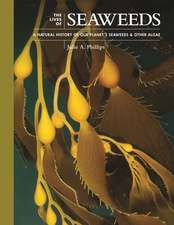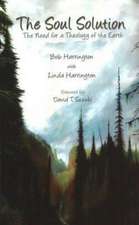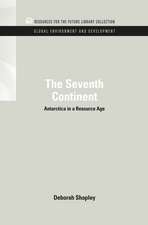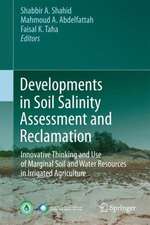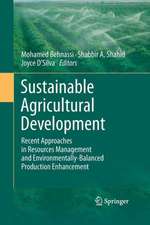Developments in Soil Classification, Land Use Planning and Policy Implications: Innovative Thinking of Soil Inventory for Land Use Planning and Management of Land Resources
Editat de Shabbir A. Shahid, Faisal K. Taha, Mahmoud A. Abdelfattahen Limba Engleză Hardback – 20 feb 2013
| Toate formatele și edițiile | Preț | Express |
|---|---|---|
| Paperback (1) | 1097.45 lei 38-44 zile | |
| SPRINGER NETHERLANDS – 23 aug 2016 | 1097.45 lei 38-44 zile | |
| Hardback (1) | 1252.61 lei 43-57 zile | |
| SPRINGER NETHERLANDS – 20 feb 2013 | 1252.61 lei 43-57 zile |
Preț: 1252.61 lei
Preț vechi: 1527.57 lei
-18% Nou
Puncte Express: 1879
Preț estimativ în valută:
239.71€ • 248.84$ • 199.88£
239.71€ • 248.84$ • 199.88£
Carte tipărită la comandă
Livrare economică 24 martie-07 aprilie
Preluare comenzi: 021 569.72.76
Specificații
ISBN-13: 9789400753310
ISBN-10: 9400753314
Pagini: 867
Ilustrații: XLVI, 867 p.
Dimensiuni: 155 x 235 x 58 mm
Greutate: 1.45 kg
Ediția:2013
Editura: SPRINGER NETHERLANDS
Colecția Springer
Locul publicării:Dordrecht, Netherlands
ISBN-10: 9400753314
Pagini: 867
Ilustrații: XLVI, 867 p.
Dimensiuni: 155 x 235 x 58 mm
Greutate: 1.45 kg
Ediția:2013
Editura: SPRINGER NETHERLANDS
Colecția Springer
Locul publicării:Dordrecht, Netherlands
Public țintă
ResearchCuprins
Part I Soil Survey and Classification Strategies in Different Ecological Zones.- 1 Innovative Thinking for Sustainable Use of Terrestrial Resources in Abu Dhabi Emirate Through Scientific Soil Inventory and Policy Development.- 2 Demands on Soil Classification and Soil Survey Strategies: Special Purpose Soil Classification Systems for Local Practical Use.- 3 Reconnaissance Soil Survey for the State of Kuwait.- 4 Do the Emerging Methods of Digital Soil Mapping have Anything to Learn from the Geopedologic Approach to Soil Mapping and Vice Versa?.- 5 Soil Thematic Map and Land Capability Classification of Dubai Emirate.- 6 Land Evaluation Interpretations and Decision Support Systems - Soil Survey of Abu Dhabi Emirate.- 7 Conceptual Soil-Regolith Toposequence Models to Support Soil Survey and Land Evaluation.- 8 Anhydrite Formation on the Coastal Sabkha of Abu Dhabi, United Arab Emirates.- 9 Fundamental Steps for Regional and Country Level Soil Surveys.- 10 Assessment of Soil Diversity in Western Siberia Using WRB 2006.- 11 Classification of the Topsoil Fabrics in Arid Soils of Central Asia.- 12 Digital Mapping of Gypsic Horizon Morphotypes and Soil Salinity in an Old Alluvial Piedmont Plain of Uzbekistan.- 13 Soils in Arid and Semi-Arid Regions: The Past as Key for the Future.- 14 Classification, Characterization and Suitability Evaluation of the Savanna Soils of Oyo North of Nigeria.- 15 Use of Soil Survey Database for the Probabilistic Evaluation of Soil Cover Transformation in the Semi-Arid Zone of Western Siberia.- 16 Soil Suitability of Northern State of Sudan to Irrigated Agriculture.- 17 Effects of Plants on Soil Forming Processes: Case Studies from Arid Environments.- 18 The Sand LandSoil System Placement (Taxonomy) and Society.- 19 Digital Soil Mapping Using Spectral and Terrain Parameters and Statistical Modeling Integrated into GIS-Northwestern Coastal Region of Egypt.- 20 Studies on the Micromorphology of Salt-Affected Soils from El-Fayoum Depression, Egypt.- 21 Correlation of Students’ Estimation and Laboratory Determination of Soil Texture.- 22 Soil Classification and Genesis in Part of Khorasan Province.- 23 Classification, Characterization and Management of Some Agricultural Soils in the North of Egypt.- 24 Semi-Arid Soils of Eastern Indonesia: Soil Classification and Land Uses.- Part II Land Use Planning and Policy Implications.- 25 Land Use Planning and Policy Implication-Bridging between Science, Politics and Decision Making.- 26 Application of Soil Survey in Land Use Planning and Policy Development.- 27 General Framework for Land Use Planning in United Arab Emirates.- 28 Spatial Mapping and Analysis of Integrated Agricultural Land Use and Infrastructure in Mhlontlo Local Municipality, Eastern Cape – South Africa.- 29 Agricultural Land Conversion: Application of Land Capability Classification in Land Use Planning of Embaderho Village in Eritrea.- 30 Assessment of Land Use Planning and Development in Nigeria: Challenges and Policy Implications on Agriculture.- 31 Soil Use Planning and Decelerating Crop Productivity: Policy Implications for Indian Punjab.- 32 Land Use Planning for Sustainable Development Using Geoinformatics: Policy Implications for Drylands.- 33 Remote Sensing and Geographical Information as an Aid for Land Use Planning and Implications to Natural Resources Assessment: Case Study – South India.- 34 Common Land Resources-The Present Status and Need for Their Conservation inNorth India .- 35 Participatory Soil and Land Evaluation Mapping: An Alternative Approach to Improve Soil and Land Evaluation Information for Decision Makers .- 36 Land Suitability Assessment of the Proposed Uranium Mining Area in North East Botswana.- 37 Sustainable Development and Management Policies for Soil and Water Conservation in Egypt .- Part III New Trends in Land Degradation and Desertification.- 38 New Trends in Land Degradation and Desertification Research and the Role of the Association DesertNet International in Sharing Knowledge and Promoting Sustainable Land Management.- 39 Land Use Planning for Controlling Land Degradation in Kuwait.- 40 Methodological Approach to Estimate In-site Costs of Desertification When Empirical Data are Not Available.- 41 Managing the Hazards of Drought and Shifting Sands in Drylands-The Case Study of Kuwait.- 42 Determining Degraded Soils of Southern Kazakhstan Through Assessing Stability of Soil Aggregates.- Part IV Modeling of Soil and Groundwater Contamination.- 43 Application of a Screening Model to Evaluate Pesticide Contamination in Soil and Groundwater for Sustainable Agriculture in Oman.- 44 Modeling of Soil Contamination and Its Remediation by In-Situ Solvent Flushing.- Part V Innovations in Research, Development, Education and Extension.- 45 Sharing Information to Accelerate Implementation of Reclamation and Improvement of Degraded Lands: WASWAC Experience.- 46 Innovations in Soil Chemical Analyses-New ECs and Total Salts Relationship for Abu Dhabi Emirate Soils.- 47 Quality Assurance Standards-USDA Perspective of the Extensive Soil Survey of Abu Dhabi Emirate.- 48 The Role of Mycorrihza in the Reclamation of Degraded Lands in Arid Environments.- 49 Preliminary Interpretation of Environmental Isotopes Datain the Ain El Atti Area (Tafilalt).- 50 Use of Lombrica to Enhance Soil Fertility for Crop Production in Madagascar.- Author’s Index.- Subject Index.
Textul de pe ultima copertă
This important addition to the technical literature of ecology is a storehouse of information on soil that includes inventories, material on databases, and details of policy developments. Soil may be just brown dirt to most people, but its sustained health is vital to the world’s ecosystems, and it is under threat as never before from contamination, degradation and salinization, among other issues. Yet soil is a precious resource: it is the essence of life, the location of innumerable chemical reactions, a filtration and nutritive system for water itself, and a versatile, if vulnerable, growing medium. Care is needed in looking after soil, since it renews itself only slowly.
As the world’s population continues to expand, maintaining and indeed increasing agricultural productivity is more important than ever, though it is also more difficult than ever in the face of changing weather patterns that in some cases are leading to aridity and desertification. The absence of scientific soil inventories, especially in arid areas, leads to mistaken decisions about soil use that, in the end, reduce a region’s capacity to feed its population, or to guarantee a clean water supply. Greater efficiency in soil use is possible when these resources are properly classified using international standards. Focusing on arid regions, this volume details soil classification from many countries. It is only once this information is properly assimilated by policymakers it becomes a foundation for informed decisions in land use planning for rational and sustainable uses.
As the world’s population continues to expand, maintaining and indeed increasing agricultural productivity is more important than ever, though it is also more difficult than ever in the face of changing weather patterns that in some cases are leading to aridity and desertification. The absence of scientific soil inventories, especially in arid areas, leads to mistaken decisions about soil use that, in the end, reduce a region’s capacity to feed its population, or to guarantee a clean water supply. Greater efficiency in soil use is possible when these resources are properly classified using international standards. Focusing on arid regions, this volume details soil classification from many countries. It is only once this information is properly assimilated by policymakers it becomes a foundation for informed decisions in land use planning for rational and sustainable uses.
Caracteristici
An essential volume for researchers and professionals working on soil use in arid and semi-arid regions Features the latest technical material on the subject from a vast range of sources A key text for students of agriculture and soil science that will get them up to speed with the latest knowledge and theories




